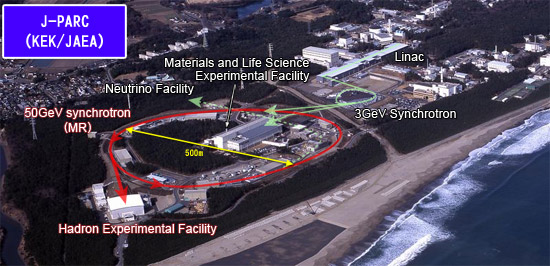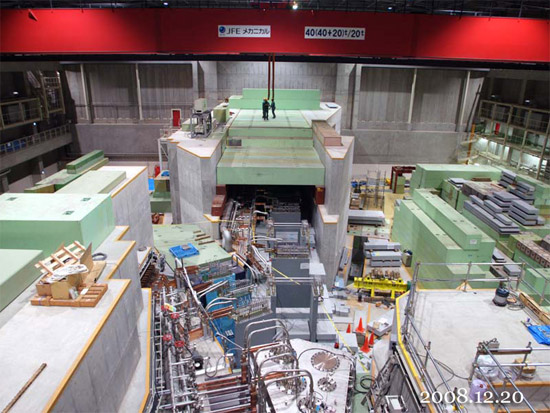| |
TOKAI-MURA, IBARAKI - A new milestone was set by the 50 GeV Synchrotron, which is the 3rd and the last stage of the accelerators of the Japan Proton Accelerator Research Complex (J-PARC), on January 27, 2009. Protons were accelerated up to 30 billion electron-volts (30 GeV), then successfully extracted to Hadron Experimental Hall in Nuclear and Particle Physics Facility and transported to the beam dump.
Since 2001, J-PARC has been jointly built by Japan Atomic Energy Agency (JAEA) and High Energy Accelerator Research Organization (KEK) at Tokai village in Ibaraki prefecture, Japan. The accelerator complex consisted of three stage, the LINAC, 3 GeV Synchrotron and 50 GeV Synchrotron, or the Main Ring.
"We are extremely delighted," says the J-PARC director Shoji Nagamiya. "After more than a decade of continuous efforts of designing and construction, we are coming to the final stage of the construction. The Main Ring, 1600 meters in circumference and 500 meters in diameter, is the last stage of the proton accelerator complex. In last December, we have reached to the beam energy of 30 GeV, at which we will operate in the first phase of the project. Proton beams are extracted and successfully injected to Hadron Experimental Hall."
The Hadron Experimental Hall is one of the two facilities at the Main Ring and utilizes the various kinds of secondary particles generated by protons.
"We will have the most powerful secondary particle beams of this energy," says Professor Kazuhiro Tanaka, who led the construction of the Hall. "We will explore the new frontier in nuclear and particle physics with high intensity hadron beams. Precise measurements of CP violation in K mesons, collective motions of strange quark in hyper nuclei, and many other new-generation fixed target experiemnts are being planned."
To make plenty of secondary particles by the high intensity proton beam available for experiments, many methods of handling the high intensity beam have been developed for this facility. In particular, firm radiation shield was constructed and the magnets that were hard to be broken and easy to be replaced, in case in trouble in the high radiation area, were produced.
The test of proton beam acceleration started in November 2006. Protons were successfully accelerated to the designed energy of the LINAC (the 1st accelerator of J-PARC) in January 2007, to the designed energy of the 3 GeV Synchrotron (the 2nd accelerator) in October 2007, and to the initial goal of 30 GeV in December 2008. This time, the protons were successfully extracted from the Main Ring to the secondary-particle production target (T1) in the Hadron Experimental Hall, located at 250 meters downstream. The beam was then successfully transported to the beam dump.
"J-PARC is the multi-purpose research complex that will contribute greatly to the advanced researches of science and technology in this century in Japan and worldwide," said Director Nagamiya. "Neutron and muon beams are already available in the Materials and Life Science Experimental Facility. With the success of the Hadron Experimental Hall, our next goal is to send high power neutrino beams into Super-Kamiokande, a large underground neutrino detector which is 295 km away. I'm sure J-PARC will contribute towards developing not only the basic sciences such as hadron and neutrino physics, chemistry and biology but also the wide applications in life science, engineering, information science, electronics and medicine."
| |
[ Related Web Site ] |
J-PARC
JAEA |
| [ Media Contact ] |
|
|
About the J-PARC project:
Yukio Oyama,
Deputy Director of J-PARC
tel. +81-29-282-6809 |
About technical contents:
Kazuhiro Tanaka,
Particle and Nuclear Physics Division, J-PARC
tel. +81-29-284-4050 |
About JAEA:
Shinichi Nishikawa,
Head of Public Relations, JAEA
tel. +81-29-282-9421 |
About KEK:
Youhei Morita,
Head of Public Relations Office, KEK
tel. +81-29-879-6047 |
 |
| Figure 1 : Aerial view of J-PARC |
 |
| Figure 2 : Hadron Experimental Hall in December 2008, before the shield was completed. |
|

